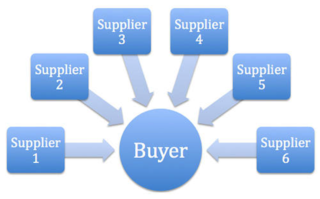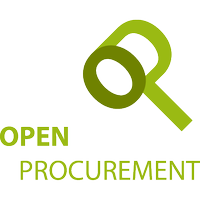A request for proposal (RFP) is a document that solicits a proposal, often made through a bidding process, by an agency or company interested in procurement of a commodity, service, or valuable asset, to potential suppliers to submit business proposals.
Procurement is the process of locating and agreeing to terms and purchasing goods, services, or other works from an external source, often with the use of a tendering or competitive bidding process. The term may also refer to a contractual obligation to "procure", i.e. to "ensure" that something is done. When a government agency buys goods or services through this practice, it is referred to as government procurement or public procurement.
A business proposal is a written offer from a seller to a prospective sponsor. Business proposals are often a key step in the complex sales process—i.e., whenever a buyer considers more than price in a purchase. When one person signifies to another their willingness to do or to abstain from doing anything with a view to obtaining the assent of the other to such act or abstinence, they are said to make a proposal.
A request for information (RFI) is a common business process whose purpose is to collect written information about the capabilities of various suppliers. Normally it follows a format that can be used for comparative purposes.
Purchasing is the procurement process a business or organization uses to acquire goods or services to accomplish its goals. Although there are several organizations that attempt to set standards in the purchasing process, processes can vary greatly between organizations.
E-procurement is the business-to-business or business-to-consumer or business-to-government purchase and sale of supplies, work, and services through the Internet as well as other information and networking systems, such as electronic data interchange and enterprise resource planning.
Strategic sourcing is the process of developing channels of supply at the lowest total cost, not just the lowest purchase price. It expands upon traditional organisational purchasing activities to embrace all activities within the procurement cycle, from specification to receipt, payment for goods and services to sourcing production lines where the labor market would increase firms' ROI. Strategic sourcing processes aim for continuous improvement and re-evaluation of the purchasing activities of an organisation.
A purchasing cooperative is a type of cooperative arrangement, often among businesses, to agree to aggregate demand to get lower prices from selected suppliers. Retailers' cooperatives are a form of purchasing cooperative. Cooperatives are often used by government agencies to reduce costs of procurement. Purchasing Cooperatives are used frequently by governmental entities, since they are required to follow laws requiring competitive bidding above certain thresholds. In the United States, counties, municipalities, schools, colleges and universities in the majority of states can sign interlocal agreements or cooperative contracts that allow them to legally use contracts that were procured by another governmental entity. The National Association of State Procurement Officials (NASPO) reported increasing use of cooperative purchasing practices in its 2016 survey of state procurement.
In the United States, the processes of government procurement enable federal, state and local government bodies in the country to acquire goods, services, and interests in real property. Contracting with the federal government or with state and local public bodies enables businesses to become suppliers in these markets.
In procurement technology, ERFx is an acronym for electronic request for [x], where x can be Proposal (RFP), Quotation (RFQ), Information (RFI) or Tender (RFT). Other pseudonymous acronyms include ITT and PQQ. All relate to a similar activity: a buyer requesting information from potential suppliers for the purpose of evaluation and comparison. Often this is part of a tendering exercise. The more structured this information is, the easier it is to compare the suppliers. For example, it is more effective to ask 20 multiple choice questions than it is to ask 2 essay questions, as long as suppliers have an opportunity to provide commentary to qualify their answers. Therefore, eRFX software should help the buyer to compare suppliers in useful ways – e.g., apples vs. apples.
Industrial marketing or business-to-business marketing is the marketing of goods and services by one business to another. Industrial goods are those an industry uses to produce an end product from one or more raw material. The term, industrial marketing has largely been replaced by the term B2B marketing.
A request for quotation (RfQ) is a business process in which a company or public entity requests a quote from a supplier for the purchase of specific products or services. RfQ generally means the same thing as Call for bids (CfB) and Invitation for bid (IfB).
Supplier evaluation and supplier appraisal are terms used in business and refer to the process of evaluating and approving potential suppliers by quantitative assessment. The aim of the process is to ensure a portfolio of best-in-class suppliers is available for use, thus, it can be an effective tool to select suppliers in the awarding stage of an auction. Supplier evaluation can also be applied to current suppliers in order to measure and monitor their performance for the purposes of ensuring contract compliance, reducing costs, mitigating risk and driving continuous improvement.

In a supply chain, a vendor, supplier, provider or a seller, is an enterprise that contributes goods or services. Generally, a supply chain vendor manufactures inventory/stock items and sells them to the next link in the chain. Today, these terms refer to a supplier of any goods or service.
Construction bidding is the process of submitting a proposal (tender) to undertake, or manage the undertaking of a construction project. The process starts with a cost estimate from blueprints and material take offs.
Qualifications-Based Selection (QBS) is a procurement process established by the United States Congress as a part of the Brooks Act and further developed as a process for public agencies to use for the selection of architectural and engineering services for public construction projects. It is a competitive contract procurement process whereby consulting firms submit qualifications to a procuring entity (owner) who evaluates and selects the most qualified firm, and then negotiates the project scope of work, schedule, budget, and consultant fee.

A reverse auction is a type of auction in which the traditional roles of buyer and seller are reversed. Thus, there is one buyer and many potential sellers. In an ordinary auction also known as a forward auction, buyers compete to obtain goods or services by offering increasingly higher prices. In contrast, in a reverse auction, the sellers compete to obtain business from the buyer and prices will typically decrease as the sellers underbid each other.
A request for qualifications (RFQ) is a step sometimes used in the formal process of procuring a product or service, for example by a government agency. It is typically used as a screening step to establish a pool of vendors that are then qualified, and thus eligible to submit responses to a request for proposals (RFP). In this two-step process, the response to the RFQ will describe the company or individual's general qualifications to perform a service or supply a product but generally will not include specific details or price proposals.

OpenProcurement is an open source procurement software toolkit that automates procurement processes. It provides tools to design and build a transparent and competitive procurement process backed by strong data collection, electronic documents, and detailed reporting.



